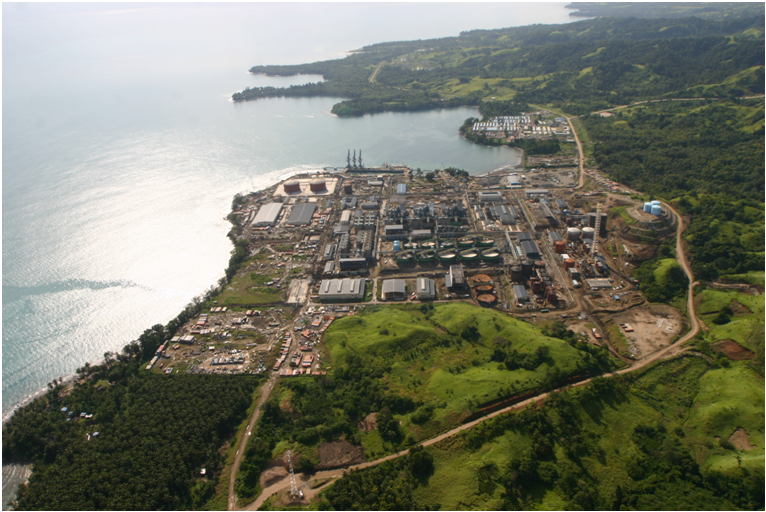Global S&T Development Trend Analysis Platform of Resources and Environment
| How do miners dispose of their waste in the sea? | |
| admin | |
| 2019-10-11 | |
| 发布年 | 2019 |
| 语种 | 英语 |
| 国家 | 国际 |
| 领域 | 地球科学 |
| 正文(英文) |  View of the Ramu Nickel mine refinery where mine waste is disposed of into the ocean in Papua New Guinea. Image by Christopher McLeod/Sacred Land Film Project.
Sea disposal of mining waste could spread as Indonesia weighs adopting the technique for new nickel projects, as Papua New Guinea is doing for a gold mine proposed by Australia’s Newcrest Mining. The management of mining waste has drawn attention since two dam disasters in Brazil, and after red mud spilled into Papua New Guinea’s Basamuk Bay from Ramu Nickel’s operations in August. An expert in chemical contamination has called test results from the Ramu Nickel spill “alarming,” media said this week. That spill resulted from an operational failure, however, rather than an issue with tailings management. Proponents say deep sea tailings placement, which pipes unwanted pulverised rock into the sea, is cheaper and less harmful, especially on tropical islands where earthquakes or heavy rain limit storage on land, near deep sea trenches. Critics say the impact of such marine disposal is poorly understood. Fewer than 20 of the world’s 2,500 mines use the method to dispose of tailings waste, comprising rock, microscopic unwanted metals and traces of processing agents, such as cyanide. Here are answers to some common questions, drawn from two research papers by Australia’s science bureau, the CSIRO. What is deep sea tailings placement?Mining waste goes down a pipe 100 m (328 ft) or more offshore designed to sink rapidly to even greater depths, such as those off the continental shelf. The waste settles on parts of the ocean floor believed to be home to few creatures. That keeps the waste out of the ocean’s most productive surface layer, where sunlight drives photosynthesis, and sealife is most abundant. After the mine has closed, advocates say the deposit area will gradually be recolonised by the marine life and bacteria that were there before, as they now move back from surrounding areas. When was it first used?The first commercial use of deep sea tailings placement was at the Island Copper mine on Canada’s Vancouver Island in 1971 to 1996. Industry regarded that as a success, though it was also found to have affected the lake’s biodiversity. Some other early mines, such as Greenland’s Black Angel lead and zinc mine, however, contaminated surrounding water bodies. Where is DSTP used now?
What are the issues?Ecological diversityA quarter of the world’s coral reefs faced rising exposure to sediments and nutrients, boosting stress from climate change and ocean acidification, Australia’s science agency said in 2016. Greater sediment could smother coral or choke off sunlight or oxygen, it said. SuspensionFine dust or metal particles remain suspended in the ocean instead of settling on the sea floor. They can “shear off” in plumes, widely dispersed by ocean currents, and travel between layers of varying salinity or temperature. The impact on marine life is not fully understood, but coral near the Lihir tailings disposal site suffered a “substantial impact”, according to the paper. Plankton could be trapped in suspended solids and fine particles could clog the gills of fish, it added. MigrationMarine animals could carry trace elements of mine waste into the food supply chain after ingesting them and then moving to shallow waters from the deep ocean. Deep seaWider use of DTSP could affect deepwater canyons and abyssal or underwater plains that are high in biodiversity, according to the research. RecolonisationOcean warming and acidification could hamper efforts to recolonise a DTSP area, it added. (By Melanie Burton; Editing by Darren Schuettler) |
| URL | 查看原文 |
| 来源平台 | Minging.com |
| 文献类型 | 新闻 |
| 条目标识符 | http://119.78.100.173/C666/handle/2XK7JSWQ/219471 |
| 专题 | 地球科学 |
| 推荐引用方式 GB/T 7714 | admin. How do miners dispose of their waste in the sea?. 2019. |
| 条目包含的文件 | 条目无相关文件。 | |||||
| 个性服务 |
| 推荐该条目 |
| 保存到收藏夹 |
| 查看访问统计 |
| 导出为Endnote文件 |
| 谷歌学术 |
| 谷歌学术中相似的文章 |
| [admin]的文章 |
| 百度学术 |
| 百度学术中相似的文章 |
| [admin]的文章 |
| 必应学术 |
| 必应学术中相似的文章 |
| [admin]的文章 |
| 相关权益政策 |
| 暂无数据 |
| 收藏/分享 |
除非特别说明,本系统中所有内容都受版权保护,并保留所有权利。
修改评论